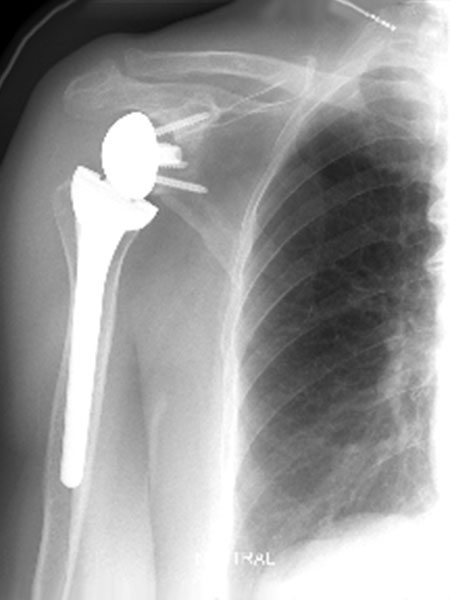This is a special type of shoulder replacement in which the components have been designed to accommodate a shoulder which is arthritic but also profoundly weak and / or unstable due to large tears of the rotator cuff tendons. A tendon is the point of attachment of a muscle into bone. Torn tendons render the muscle ineffective and over time it wastes away from disuse. Although being small muscles, the rotator cuff assists the bigger muscles of the shoulder to move the arm.
This type of problem, called Rotator Cuff Arthropathy, typically affects patients in their 70s and 80s.
In a standard replacement, the shallow socket on the side of the shoulder blade and the ball at the upper end of the humerus (arm bone) are replicated with a prosthesis, which looks like the normal shoulder. However, if the rotator cuff tendons are torn, the shoulder will remain weak.
Reverse Total Shoulder Replacement, as the name suggests, has a ball on the shoulder blade side and a socket on the humerus side. This arrangement makes things more stable and dramatically improves power and function of the shoulder. It is mainly used for rotator cuff arthropathy but is sometimes used for severe fractures and other patterns of arthritis.

Before Surgery
This is generally an operation for someone in their 70s and 80s – usually with severe pain, loss of function and poor shoulder strength. An anaesthetic assessment and any other relevant medical specialist consultations will be required preoperatively. Usually an MRI scan and a CT scan will be required if surgery is to proceed. A full discussion regarding the advantages and risks of surgery will take place. A second consultation for further questions and final planning is usual.
Surgery and Recovery
The operation will be performed under a general anaesthetic and the anaesthetist will do a local anaesthetic nerve block which will relieve pain for the first 48 hours. Most patients find the initial pain after the surgery to be minimal and better than their preoperative pain within a short period of time.
A sling will be required for 6 weeks, but during this time certain exercises will be performed daily. A physiotherapist will be involved. You will not be able to use the affected arm much for 6 weeks. Assistance at home will be required. Alternatively, a short admission to the rehabilitation unit is available. After 6 weeks you can remove the sling and begin moving your arm more freely. Expect gradual improvements in mobility and function over 3 to 6 months.

 02 6621 25 88
02 6621 25 88
